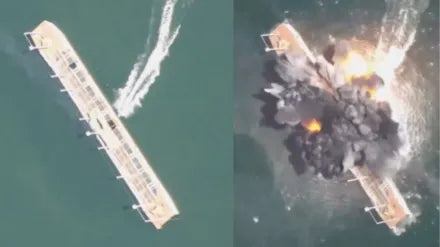Russia Deploys Sea Drone to Sink Ukraine's Largest Naval Ship, Casualties Reported

In a significant development in the ongoing conflict, Russia has announced the destruction of Ukraine's largest active naval vessel, the reconnaissance ship Simferopol. This incident is being marked as Moscow's inaugural successful attack employing a sea drone.
Ukrainian Navy spokesperson Dmytro Pletenchuk reported that the attack resulted in the death of one crew member, with several others unaccounted for. However, most of the crew have been reported safe, and search and rescue efforts are currently underway.
The Russian Defense Ministry confirmed that a naval drone targeted the Laguna-class medium reconnaissance ship in the Danube River delta, located in Ukraine's Odessa region. The Simferopol, designed for various surveillance operations, was launched in 2019 and officially became part of the Ukrainian Navy in 2021. Russian media and the WarGonzo Telegram channel have identified it as the largest Ukrainian naval ship commissioned since 2014.
An expert on unmanned aerial vehicles, quoted by TASS, highlighted that this attack represents the first use of a sea drone to destroy an enemy vessel. Analysts have observed that Russia has been increasing its production of unmanned aerial and naval systems in recent months, viewing them as integral to its evolving military tactics.
Concurrently, Ukrainian forces claimed that they had struck a Russian warship equipped with missiles in the Sea of Azov on Thursday. Ukrainian military intelligence stated that the vessel, reportedly located in the Kalibr missile launch zone near Temryuk Bay, had to retreat from combat duties after being targeted.
The incident occurs alongside Russia's alleged missile attack on a drone production facility in Kyiv, which was reportedly used for manufacturing Turkish Bayraktar drones. Ukrainian politician Igor Zinkevich confirmed the facility was hit by two missiles.
On the international stage, the United States has finalized an $825 million arms deal with Ukraine. This package, including long-range missiles and support equipment, was arranged in collaboration with NATO allies Denmark, the Netherlands, and Norway. According to the U.S. State Department, the funding will be provided through foreign military financing and contributions from allies.
Despite Washington's ongoing military support, diplomatic efforts to negotiate peace remain at a standstill, with U.S. officials acknowledging minimal progress in resolving the differences between Kyiv and Moscow.



















